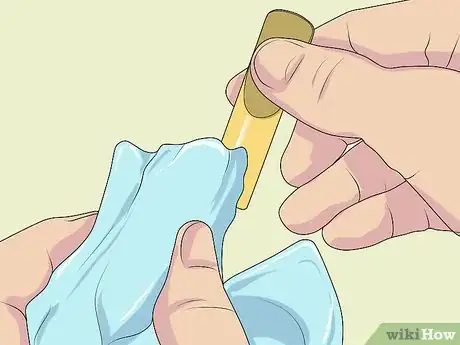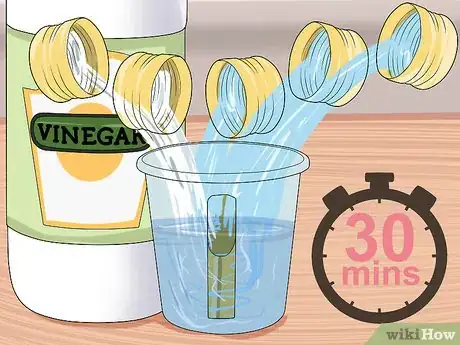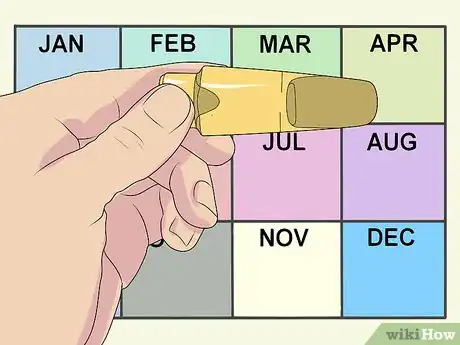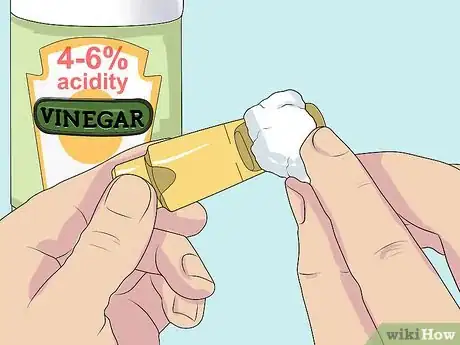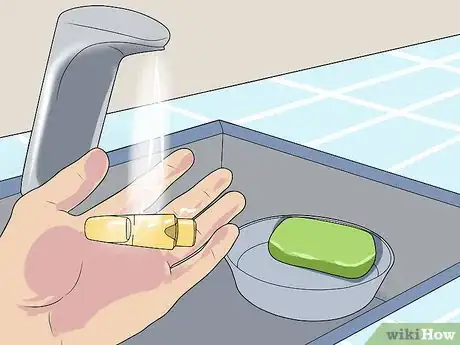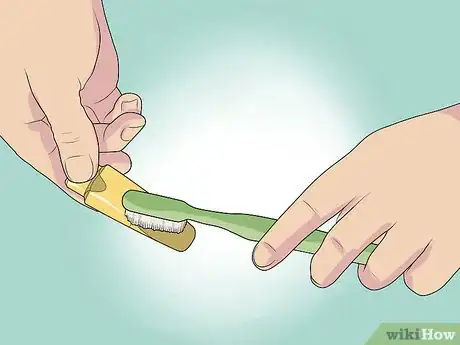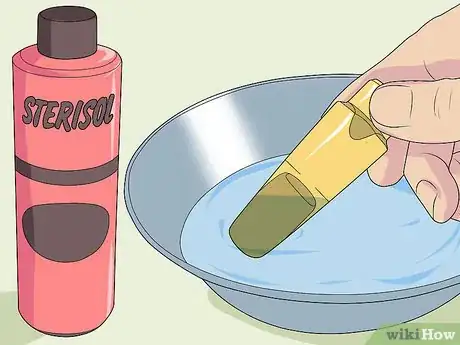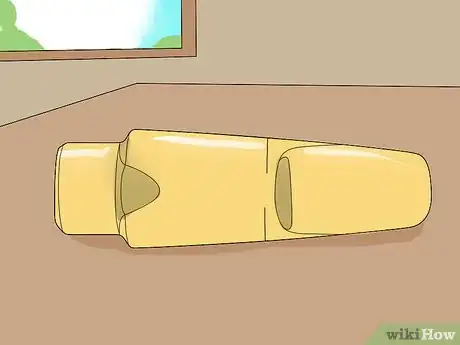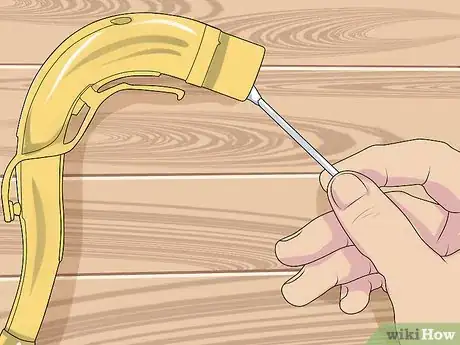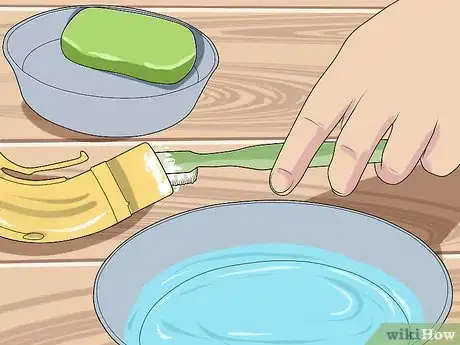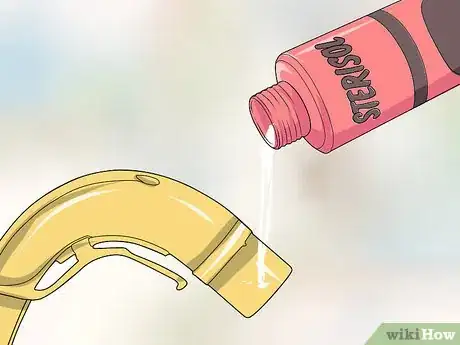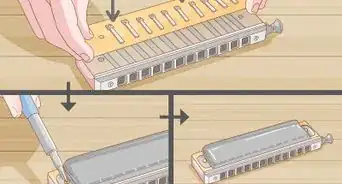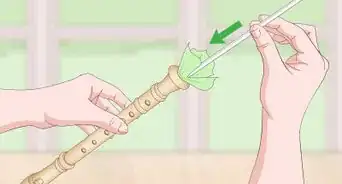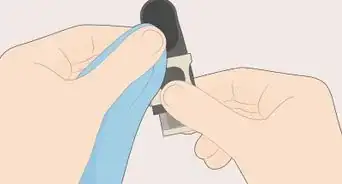This article was co-authored by wikiHow Staff. Our trained team of editors and researchers validate articles for accuracy and comprehensiveness. wikiHow's Content Management Team carefully monitors the work from our editorial staff to ensure that each article is backed by trusted research and meets our high quality standards.
There are 12 references cited in this article, which can be found at the bottom of the page.
This article has been viewed 55,443 times.
Learn more...
The mouth is full of bacteria and food particles, so playing a reed instrument such as a saxophone is dirty business. Without proper cleaning, a saxophone mouthpiece can house all sorts of buildup and even mold that can cause illness.[1] With a little care, your saxophone can sound great for years to come.
Steps
Cleaning the Reed
-
1Disassemble the saxophone. Loosen the ligature, then remove the mouthpiece, its reed, and the saxophone’s neck. You’re going to want to clean these parts often since they come in contact with your mouth. The reed is the part of the mouthpiece that produces sound from vibration and is sensitive to bacteria, fungus, heat, and pressure.
-
2Wipe off the reed. The warm air you blow into it contains saliva, which provides a moist place for bacterial and fungal growth as well as food particles that damage the instrument.[2]
- A reed that is cleaned often requires at least a wipe down with a clean, dry towel or specialized swab after every use. This will stop bacteria and chemicals from congealing.[3]
- Specialized swabs and brushes for saxophone cleaning can be bought at music stores or online.
Advertisement -
3Deep clean the reed. A wipe will only remove the immediate moisture. To kill germs and prevent buildup, a more thorough cleaning is recommended.
- At least once a week, soak the reed in a cup of two caps of vinegar and three caps warm water for 30 minutes. Afterwards, rinse the reed with warm water to remove the vinegar.[4]
-
4Choose a clean spot for the reed to dry in open air. Any moisture can reintroduce bacteria when it is sealed inside the saxophone case. Place it on a paper towel. After about 15 minutes, replace the paper towel and flip the reed. Once it is completely dry, store it in a reed bag inside your saxophone’s case.[5]
Cleaning the Main Mouthpiece
-
1Treat the mouthpiece regularly. Once a month, or weekly, if the saxophone is used daily, remove the mouthpiece and begin treatment. Saliva collects in the mouthpiece, causing buildup of a substance called limescale that affects the sound and makes the mouthpiece difficult to remove.[6]
-
2Apply a weak acid. If the limescale has thickened, an acidic substance such as vinegar or hydrogen peroxide works for the purpose of removal. Exposure to these acids can hasten discoloration, though, so you may wish to brush off the limescale by hand if possible.[7]
- With a vinegar of 4-6% acidity, soak two cotton wads. Let the first rest on the window of the mouthpiece. After ten minutes, remove it and gently rub off the limescale with the second. Repeat a second time for tough cases.
- With hydrogen peroxide, submerge the mouthpiece for two hours. The chemical will begin to dissolve the limescale on its own.
-
3Wash the mouthpiece with soap and water. Avoid hot water and harsh detergents, as these both damage the instrument. A gentle detergent and lukewarm water is enough to remove vinegar, eliminate most bacteria, and still allow you to get at the limescale.[8]
-
4Brush away the limescale. This can be done with a small toothbrush or a specialty mouthpiece bottlebrush.[9]
- Specialized swabs can be pulled from the neck and through the mouthpiece on a string. This offers some bacterial and saliva removal, but a more thorough cleaning is recommended.
-
5Soak the mouthpiece in germicide. Sterisol is a germicide readily available for use on instruments, but bathing the mouthpiece in household mouthwash for a few minutes is also effective. This step is not mandatory but is useful in eliminating any leftover bacteria.
-
6Choose a clean spot in open air for the mouthpiece to dry. This will prevent the mouthpiece from reintroducing dampness that allows bacteria to grow. Once all moisture is gone, store it in the saxophone case.
Cleaning the Neck
-
1Run a swab through after use. Saliva and build up collect in the neck. Put the swab in the bell and then pull it through the neck on a string.[10]
-
2Remove the limescale. This is the same process you used on the mouthpiece, requiring warm water, soap or detergent, and a bottlebrush or toothbrush to be used weekly.
- Dip the brush into the warm, soapy water and use it to attack the limescale. Rinse out the remainder under a faucet with lukewarm water.[11]
-
3Sterilize the neck. Again, this is optional, as the soap and water takes care of the bacteria well enough. Any leftover bacteria or odor can be finished with certainty here.
- Pour Sterisol germicide into the neck so that it coats the inside. Let it dry in a clean place on a paper towel for a minute, then rinse it under lukewarm water. Either let it air dry or dry it by hand with a swab or towel before storing.
- Vinegar can be used here, too. After loosening the limescale with soap, water, and brushing, stop the mouthpiece with a cork. Surface cover any holes, prop the neck upright, then add either cold or lukewarm vinegar. After 30 minutes, rinse out the vinegar with soap and warm water, then dry it in air or by hand.[12]
Community Q&A
-
QuestionWhen I am playing my sax, I get a lot of moisture that starts to blow out of the side of the mouthpiece. How often should I remove the mouthpiece from the neck and shake out the excess water?
 Community AnswerEvery 10 to 12 minutes would be good, but instead of shaking it out, hit the joint (the part of the mouthpiece that connects to the neck) on your leg; the spit will most likely come out. If that doesn't work, buy a cleaning cloth.
Community AnswerEvery 10 to 12 minutes would be good, but instead of shaking it out, hit the joint (the part of the mouthpiece that connects to the neck) on your leg; the spit will most likely come out. If that doesn't work, buy a cleaning cloth. -
QuestionWhat is the size of a pad felt for alto saxophone?
 KookieCommunity AnswerIt can be any size! It depends on what saxophone size or what type you are using.
KookieCommunity AnswerIt can be any size! It depends on what saxophone size or what type you are using.
Warnings
- Don’t use household tools to pick at any deposits. This scratches surfaces and deforms the reed.⧼thumbs_response⧽
- Don’t throw the pieces into the dishwasher. The heat and detergent will damage them.⧼thumbs_response⧽
Things You'll Need
- Running water
- A towel or swabs
- A toothbrush or speciality bottlebrush
- A light detergent or soap
- Vinegar
- Mouthwash (optional)
References
- ↑ http://www.huffingtonpost.com/2013/11/08/saxophone-lung-clean-clarinet-instrument-woodwind_n_4221368.html
- ↑ https://www.nemc.com/instrument-care-instructions/saxophone-care
- ↑ https://tamingthesaxophone.com/saxophone-mouthpiece-cleaning
- ↑ http://ourpastimes.com/clean-saxophone-reed-4869307.html
- ↑ http://www.bestsaxophonewebsiteever.com/8-saxophone-care-tips-you-may-have-never-heard/
- ↑ https://www.indwes.edu/undergraduate/majors/division-of-music/health-and-safety-information
- ↑ http://www.shwoodwind.co.uk/Testing/Cleaning_mouthpieces.htm
- ↑ http://www.mellowood.ca/music/essays/saxclean.html
- ↑ https://beginningsax.com/faqs/
About This Article
To clean your saxophone's mouthpiece, start by wiping down the reed with a dry towel after each practice session to remove saliva. Additionally, you should soak the reed in warm water and vinegar to deep clean it. Then, rinse off the vinegar and let the reed dry, repeating once a week. To clean the mouthpiece, wipe it with a cotton swab soaked in vinegar to get rid of limescale. Next, wash the mouthpiece with soapy water to remove the vinegar, repeating once a month. You can also try to clean off limescale with a toothbrush. For tips on how to use germicide on your mouthpiece and how to clean the neck, read on!

